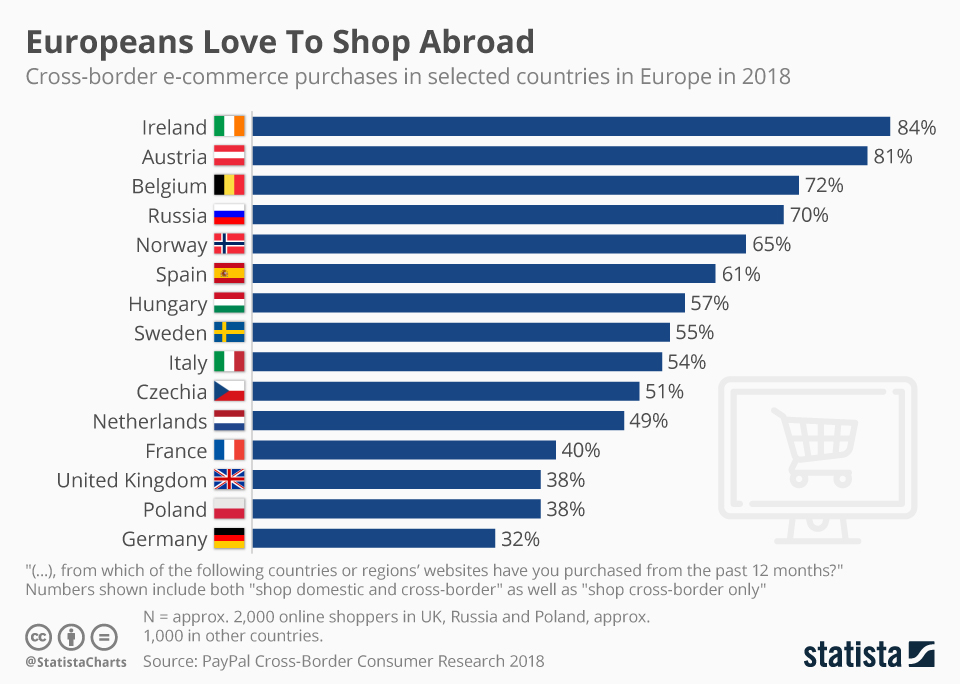
Consumer needs are in constant change, which now means that marketers have a lot to do to cope with the changes. It makes sense for every marketer to want to stay ahead of this curve of change. The fact remains that the more you know about the people that are going to consume your services and products, the higher the chances you will have of increasing their demand and making more sales.
The internet is full of information about consumers of different products. Though, to get into the mind of your specific niche, you need to move with the wave. This way, you will know what they expect and what they are looking for when shopping online. This information will inform the move you will take to adjust your store to those needs and expectations. This brief covers the 10 must-know shopping statistics of 2020 and all the trends that you must familiarize yourself with. The information will help you better understand your customers and how they shop.
1.8 Billion People worldwide shopped online (Statista 2018)

A 2018 study revealed that there are about 1.8Billion people worldwide that purchase most of their products online. The global e-retail sales were $2.8Trillion the same year. The same statistics show that e-retail sales are going to grow up to about $4.8 Trillion by 2021. This growth in online shopping is very impressive to all marketers. Though, there's a growing competition a reason why you should be very active on this to be somewhere in the list of top marketers and sellers.
Men spend more than women at 68%
This statistic is shocking because no one expected men to spend more on online shopping than women. Though, when you think about it, it makes a lot of sense. The statistics show that the average man would spend $69 more than a woman. As a matter of fact, it shows that men spend $220 per transaction as opposed to $151 that women spend per transaction. What these statistics show is that men spend more per transaction than women. This doesn’t prove that men shop more than women, only that they buy more in one transaction.
This statistic is clear that male shoppers are likely to buy higher-priced commodities than their counterparts. The reason behind this is because as women concentrate on accessories, clothes, and shoes, men would go for an electronic or an expensive grooming product. Additionally, men tend to be efficient by bulk buying to save time. This means that when selling to a male audience, you should offer related products and effective deals to boost your conversions.
Generation X shop more online than any other age group (KPMG)
Another important statistic to show here is that ‘’generation Xers’’ or people born between 1966-1981 shop more online as to compare to the Baby Boomers and Millennial. The statistics show that Generation X averages nearly 19 transactions per year. I know how confusing this sounds, but it’s true. Someone would expect that Millennial are more online shoppers because they are computer natives.
This statistic shows that Millennials don’t have many expenses and busy life to go to a local shop and buy. However, as they grow older and enter the workshop and start their families, they will tend to spend more and save most of their time shopping online. Millennials will only shop when there are value propositions they can easily identify. This means that they see most products they buy as a reflection of their image, and if that product doesn't meet this, they will definitely disqualify it. If you want to market the products to this group, you must create a value proposition they can notice.
A great number of consumers shop via Mobile (Ibotta, 2018)

This statistic shows that more than 50% of all the people shop online. Although this was not the case previously, mobile shopping is on the rise. What this means for most eCommerce owners is that you don’t have to ignore mobile users and specifically mobile shopping. For that reason, your eCommerce website should be optimized well for mobile shopping. In terms of retail website visits, Smartphone users were leading, so it was regarded as the number one device that people use to shop online and place orders.
Taobao is the biggest online marketplace (Statista, 2019)

The biggest platform in the world, according to Statista, is Taobao. This platform has a GMV of $515 Billion. Tmall and Amazon followed closely with $432 and $344 Billion annually, respectively. With such information, it is very clear that the competition in the retail market is on the rise every day.
eWallet is the preferred payment method for mobile shopping
This is surprising, but the fact remains that eWallet has been ranked as the most preferred method of payment among the shoppers. The statistics show that more than 36% of online shoppers used this method of payment. The second popular method included credit and debit cards. eWallet includes online payments and in-person purchases that help someone to make electronic transactions.
The biggest ecommerce market in the world is China
According to statistics, China is known as the largest eCommerce market in the world in terms of goods and services. They sold products and services worth $333.45 billion, which is a clear representation of 22.9% of the total sales.
Shoppers need new products constantly
The statistics show that nearly 75% of all the consumer search queries are about brand new products and services. For that reason, a great number of them expect new products each day. So if you want to be successful in online retail, always update with new products.
62% of online buyers shop at least once a month (Episerver, 2019)
I know you are wondering how often people shop. According to statistics, 62% of all the people will shop at least once a month. Three percent of the shoppers claim they shop at least once a day. This means that people are shopping more regularly with time.
Fashion related products are the leading products
Statistics show that more than 57% of all the online shoppers shopped for related fashion products. Footwear was also ranked as the second most popular product online, according to Statista, 2019. Besides the fact that there's a lot of risks involved in this industry, people still consider clothes and fashion products as the top priority for online shopping.


